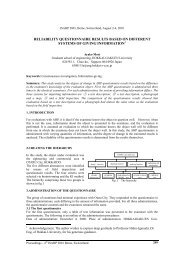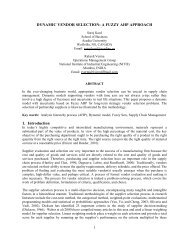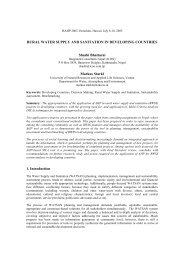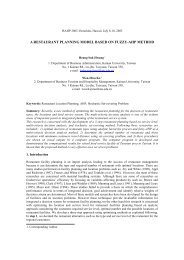A NEW METHOD OF JOB EVALUATION - ResearchGate
A NEW METHOD OF JOB EVALUATION - ResearchGate
A NEW METHOD OF JOB EVALUATION - ResearchGate
You also want an ePaper? Increase the reach of your titles
YUMPU automatically turns print PDFs into web optimized ePapers that Google loves.
with the below restrictions applied on parameters:α 0 > 0, α 1 > 0, α 1 ≠ 1where: Y i – numerical values of verbal evaluations,α 0 , α 1 − model parameters,x i – quantified verbal evaluationsε i – random deviationThe idea behind this method is exponential increase of numerical valuesof analytic values (intensity) in comparison with verbal evaluations. The aim ofsuch action is to cause a strong, healthy competition between employees in acompany working on different job posts. A post higher in the hierarchy of acompany related to an analytic criterion is “rewarded” with higher exponentialpriority (weight) and numerical intensity of the criterion. However, it is notdirectly proportional to verbal evaluation. For example professional education(Pi = 0.072) in comparison with vocational one (Pi = 0.048) needs lessintellectual effort than higher education (Pi = 0.473) in comparison withvocational one (Pi = 0.072). It seems to be obvious, but has not been reallyreflected in previous methods of job evaluation. An educated, experiencedemployee makes a greater contribution than an inexperienced one, thus the nonlinear“bonus” for the best employees in an organization.Table 6. Example of numerical estimation on importance of verbal evaluation ona 5-point scaleVerbalintensityVery high High Average Small VerysmallPi(priority)Very high 1 2 3 4 5 0.4174High ½ 1 2 3 4 0.2634Average 1/3 ½ 1 2 3 0.1602Small ¼ 1/3 ½ 1 2 0.0975Very small 1/5 ¼ 1/3 ½ 1 0.0615Total 1.0000Source: personal study C.R. = 0.015Fig. 3. Numerical importance of evaluations for a 5-point scale11









